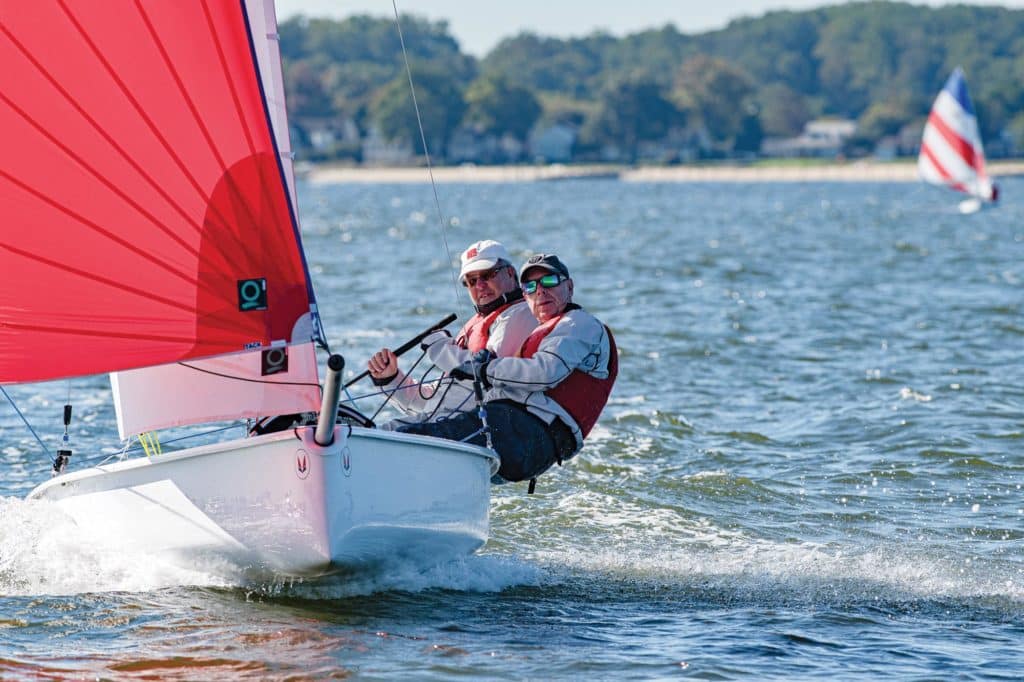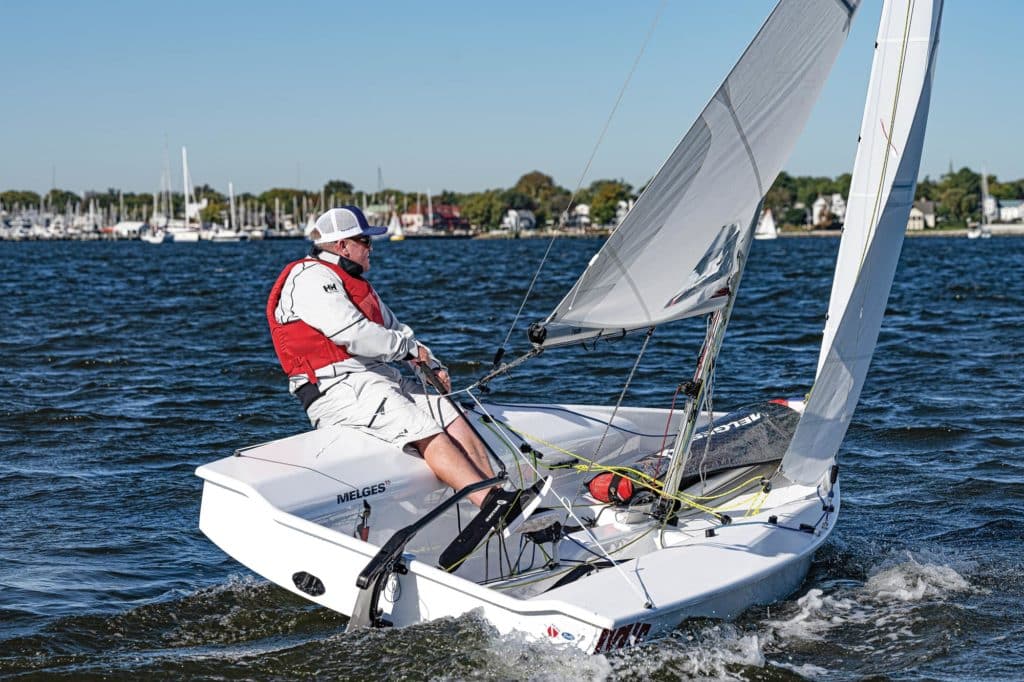Sailing World Magazine’s annual Boat of the Year tests are conducted in Annapolis, Maryland, following the US Sailboat Show. With independent judges exhaustively inspecting the boats on land and putting them through their paces on the water, this year’s fleet of new performance-sailing boats spanned from small dinghies to high-tech bluewater catamarans. Here’s the best of the best from our 2022 Boat of the Year nominees »
Out yonder in the vast cornfields of Wisconsin, boatbuilders in Tyvek suits are infusing polyester glass hulls as fast as they can, buffing out one gleaming white dinghy nearly every 66 hours in a full-tilt routine to place the latest American-made dinghy into the hands of sailors clamoring to get a piece of the new great thing in small-craft sailing: the remarkably versatile Melges 15, our 2022 Boat of the Year. No longer shall youth and adult sailors be cast to their individual dinghy classes, and our judges agree. This one allows all ages to play together in one remarkable 15-footer.
“It’s stable, forgiving and accessible to a wide swath of physiques, a platform where you can learn to sail it and then transition quickly to racing,” says Eddie Cox, the youngster of Melges Performance Sailboats who’s been involved with the Melges 15’s development from inception to launch. “The boat fits a wide variety of sailors, and that’s what our goal was. It’s family-orientated sailing, which is important to us because that’s how Melges boats are.”
While the Reichel/Pugh-designed Melges 15 was originally introduced in May 2020, its BOTY appearance was delayed to 2021, and clearly neither the class nor the builder was waiting for its award. In less than a year, multiple fleets have been seeded and growing across the country, with more than 150 boats sailing and another 175 or so already on order as of October 2021. Demand is, of course, outpacing supply, but the folks out in Zenda don’t mind that one bit.
The most notable trait the judges noted as they observed the boat on land during October’s United States Sailboat Show is its deep cockpit, which puts the boat in a similar space as the Club 420. But that’s about where comparisons end. In fact, during post-sailing deliberations, the judges found it impossible to identify another doublehanded dinghy quite like it, aside from the 25-year-old RS200 class, which is only active in Europe. So, there’s a golden opportunity for the Melges crew in the non-skiff, doublehanded asymmetric-spinnaker market.

The Melges 15’s best trait under sail, however, is its stability. The hull’s wide after sections and sharp chines push a lot of buoyancy outboard, says Greg Stewart. Examine the hull profile from aside the boat on its dolly and it’s easy to see the rocker too, which encourages early planing and a smooth ride uphill while also making it responsive to crew-weight adjustments as wind conditions change.
On deck, the judges took note of the open foredeck, which allows you to safely and comfortably walk or crawl to the bow should you need to when landing or correcting the inevitable spinnaker snafu. Mounted on the foredeck is the asymmetric spinnaker turtle with a stainless-steel throat bar and aluminum retracting sprit. The single-line spinnaker hoist and retrieval system leads to a cam cleat near the mast base and runs aft to a turning block at the transom, so either the helmsman or crew can manage the hoist. Pin-stop adjustable jib tracks are mounted on the side tanks, and sheets lead to ratchet blocks with stand-up rubber boots to provide the appropriate cross-sheeting angles.
Here, in the crew’s playground, a lot of design focus went into the height, width and construction of the boat’s backbone, making it a comfortable seat to straddle in lighter winds. The aluminum-reinforced centerboard box, Cox says, also provides extra strength in the trunk and allows Melges to build the boat more economically. The trunk tapers downward sharply aft toward the floor to provide an anchor point for the mainsheet block. From there, it’s a clean run aft with only the skipper’s hiking straps.

While the trend in dinghy design has been toward open transoms, doing so requires raised floors in order to drain water. To maintain a deep cockpit, Melges instead opted for tried-and-true stainless-steel Elvström/Anderson Bailers, as well as flaps in the transom should the sleigh ride be especially wet and wild.
Aiming to keep the rig tuning quick and simple, the two-part tapered aluminum Selden rig has a single-length forestay and adjustable turnbuckles, while gross settings for varying crew combinations can be made with adjustable spreader brackets for rake and spreader length.
“Put a Loos tension gauge on the forestay, tune the rig up until you hit 19 on the gauge, and that’s your base setting,” Cox says. “When it gets windy, put on a few more turns at the shrouds and that’s how you get to 24, which is your heavy-air setting. It’s all pretty simple. The boom-top mounted vang is anchored on the mast with the sliding track on the boom, which is a clean solution to keep the crew’s runway clear and have a powerful tool to depower the rig (the cleat is on a mast-mounted swivel).
The centerboard and rudder are both aluminum with rubber end caps, which is the go-to solution for maintenance-free appendages these days—less time fairing and fussing means more time sailing, and this is especially true for boats destined for sailing and yacht-club fleets.
“Our goal is to help the sport grow and help racing grow,” Cox says. “We think one problem with American sailing is getting younger sailors out of high school or college sailing into their next race boat. Going fast and being able to go 20 knots downwind hooks people—we need to make sure we are making sailing fast, fun and exciting.”
When the judges got their time in the boat with a fresh 15-knot northwest wind, they witnessed firsthand what Cox had promised. To prove a point of its versatility, veteran judge and college sailing coach Chuck Allen commandeered the 15 alone, set the red spinnaker, and was immediately a projectile—soon a red speck on the horizon.
“The stability of this really opens it to such a wide range of sailors,” Allen says. “The build quality is superb, and it is so clean. It’s classic Melges. They really took their time with it before putting it out there. Its stated purpose is right on target, the price point is good, and with that stability it sails incredibly well upwind and downwind.”
Once they were able to wrestle the tiller from Allen’s hands, fellow judges Greg Stewart and David Powlison, tipping the scales at 420 pounds combined, set off on a few speed burns of their own, climbing to windward in 12 knots of breeze at narrow angles, and effortlessly planing off downwind, knocking through jibes with ease after only a few minutes in the boat.
“Of all the boats we sailed, it was the one I really didn’t want to get off of,” Stewart says. “For me, selecting it as our Boat of the Year comes down to execution of the build and its performance. It’s exceptional in all ways. Everything is so well-integrated and clean. It starts with a good designer, and then it’s good product development and craftsmanship—there’s nothing on this boat that you don’t need.”
Powlison seconds Stewart’s praise for the boat, especially the part about how it serves such a wide variety of crew combinations. “It’s not just a race boat, but a boat to go sail and have fun with anyone, anytime.”









